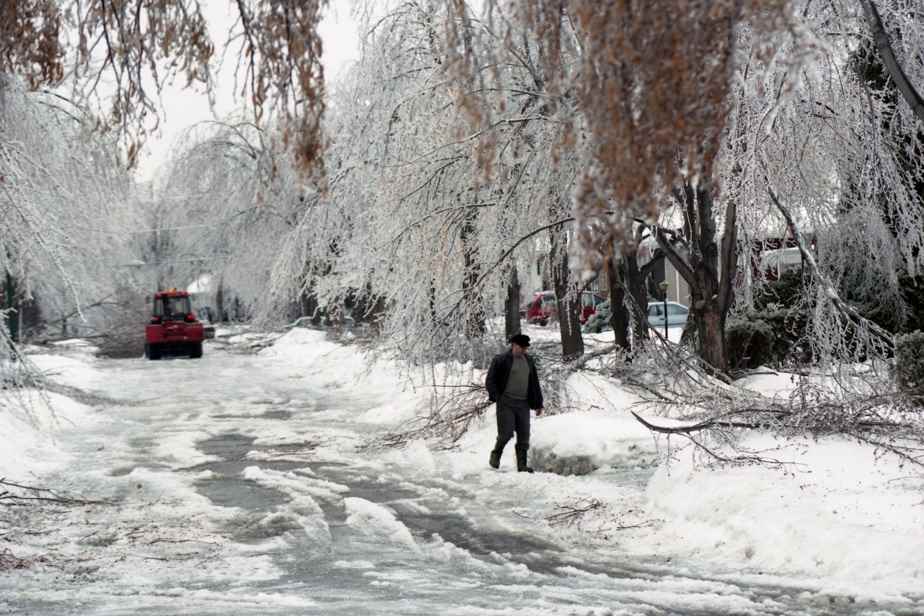Monday, January 5, 1998
Between 10 and 20 mm of freezing rain falls on southern Quebec. Flights are canceled or delayed in Montreal. In the evening, 450 homes are without power.
Tuesday, January 6, 1998

PHOTO DENIS COURVILLE, LA PRESSE ARCHIVES
As of January 6, the devastating effects of the ice storm are felt. Especially on trees.
No less than 34 mm of freezing rain fell on the greater Montreal area. Some 700,000 customers are without electricity. Eight pylons of a 735 kV transmission line collapse near Drummondville.

PHOTO PIERRE MCCANN, LA PRESSE ARCHIVES
The damage is already significant on January 6, as here in Montreal, but the freezing rain will continue to fall.
Wednesday, January 7, 1998
-

PHOTO ARMAND TROTTIER, LA PRESSE ARCHIVES
Pylons collapsed under the weight of the ice in Montérégie
-

PHOTO DENIS COURVILLE, LA PRESSE ARCHIVES
Transmission lines cut in Montérégie
-

PHOTO ARMAND TROTTIER, LA PRESSE ARCHIVES
Pylons collapsed under the weight of the ice in Saint-Césaire, in Montérégie
1/3
Some 7.5 mm of additional freezing rain accumulates; 435,000 customers are without electricity. The first shelters open their doors. The CEO of Hydro-Quebec, André Caillé, who was out of the country, returns to Montreal.
In addition, 72 pylons collapsed between Boucherville and Saint-Césaire. The post of Saint-Césaire falls; 14 120 kV lines are affected.
-

PHOTO ARMAND TROTTIER, LA PRESSE ARCHIVES
Pylons collapsed under the weight of the ice in Montérégie, January 10, 1998
-

PHOTO DENIS COURVILLE, LA PRESSE ARCHIVES
Marieville
-

PHOTO DENIS COURVILLE, LA PRESSE ARCHIVES
In the region of Saint-Hyacinthe
-

PHOTO ARMAND TROTTIER, LA PRESSE ARCHIVES
Some of the many soldiers deployed on the ground to help clean up the damage. Here, in the region of Saint-Hyacinthe and Saint-Thomas.
1/4
Thursday, January 8, 1998
A total of 23 mm of freezing rain. There are now 1,023,000 customers without electricity. Some 2,800 members of the Canadian Armed Forces are deployed with 8,000 camp beds. In Dorval, 215 flights are canceled and many others delayed.
At 10:05 a.m., Montreal declares a state of alert and launches its emergency measures plan. The mayor of Montreal, Pierre Bourque, on vacation in China, returns to Montreal.

PHOTO ARMAND TROTTIER, LA PRESSE ARCHIVES
A scene of the devastation of the ice storm on the South Shore taken on January 8, 1998
Friday, January 9, 1998
In Montreal, an additional 14 mm of freezing rain, for a total ranging between 88.5 and 98.5 mm. About 1.4 million subscribers are without power.

PHOTO DENIS COURVILLE, LA PRESSE ARCHIVES
The Canadian army called in reinforcements. Here on January 9, in Montérégie.
A major blackout plunges virtually the entire island of Montreal into darkness.
Filtration plants are shut down.

PHOTO MARTIN CHAMBERLAND, ARCHIVES LA PRESSE
Downtown Montreal, the evening of January 9
The Victoria, Jacques-Cartier and Champlain bridges are closed due to falling pieces of ice.
Prime Minister Lucien Bouchard announces the arrival of 3,000 other soldiers.
Saturday, January 10, 1998

PHOTO MARTIN CHAMBERLAND, ARCHIVES LA PRESSE
Icebreaking work on the Champlain Bridge, January 10
About 1 million customers still without electricity around 6:30 p.m. in Quebec.
More than 800 linemen from the United States are in Quebec.
The Mercier Bridge closes in turn.
-

PHOTO ARMAND TROTTIER, LA PRESSE ARCHIVES
Pylons collapsed under the weight of the ice, January 10, in the region of Saint-Hyacinthe and Saint-Thomas
-

PHOTO ARMAND TROTTIER, LA PRESSE ARCHIVES
Pylons collapsed under the weight of the ice, January 10, in the region of Saint-Hyacinthe and Saint-Thomas
-

PHOTO MARTIN CHAMBERLAND, ARCHIVES LA PRESSE
The ice storm caused the collapse of hundreds of pylons, like here in the Varennes region.
1/3
Sunday, January 11, 1998
The Rolling Stones show scheduled for Olympic Stadium is postponed.

PHOTO BERNARD BRAULT, PRESS ARCHIVES
Jacques-Cartier bridge icebreaking operation, January 11
Monday January 12
The balance sheet of outages is reduced to 551,000 subscribers.
There are more than 9,300 Canadian soldiers, including 3,500 from Valcartier, active in 50 municipalities in Quebec.

PHOTO ROBERT SKINNER, LA PRESSE ARCHIVES
The Hydro-Québec command center during the crisis
Tuesday January 13
At 5:00 p.m., Hydro-Québec turns off the neon sign at its head office on René-Lévesque Boulevard. The state-owned company is asking Quebecers to reduce their electricity consumption and is setting an example.

PHOTO ARMAND TROTTIER, LA PRESSE ARCHIVES
Strong symbolic measure: Hydro-Québec extinguishes the neon sign of its head office in Montreal, on January 13.
Wednesday January 14
A total of 376,700 subscribers are without electricity.
Hydro-Québec authorizes the reopening of businesses and office towers in the city center on the condition that users consume electricity with great moderation.
Tuesday, January 20
For the first time in 12 days, service is back to normal on the entire Montreal metro.
Sunday January 25

PHOTO BERNARD BRAULT, PRESS ARCHIVES
Hydro-Québec linemen in a pylon in Saint-Césaire, January 24
The Saint-Césaire and Richelieu substations are reintegrated into the network.
Wednesday, January 28, 1998

PHOTO JACQUES BOISSINOT, CANADIAN PRESS ARCHIVES
André Caillé, January 28
At the end of a meeting of the Council of Ministers, André Caillé unveils the details of an 815 million plan for the construction of loops to strengthen the electricity transmission network.
The Government of Quebec adopts a decree creating a scientific and technical commission responsible for analyzing the events relating to the ice storm. Chaired by Roger Nicolet, the Commission submitted its report on April 7, 1999.
Friday, February 6, 1998
Hydro-Québec relights its symbol at head office.
Monday, February 9, 1998
The Press headline announcement that the last Hydro-Quebec customers have been reconnected.
Sources: hydroquebec.com/ice-1998/, STM, Hydro-PressJanuary 2018, Canadian Armed Forces, Digital Museums Canada, Archives de Montréal, The duty, Radio Canada, The sun, The Press
